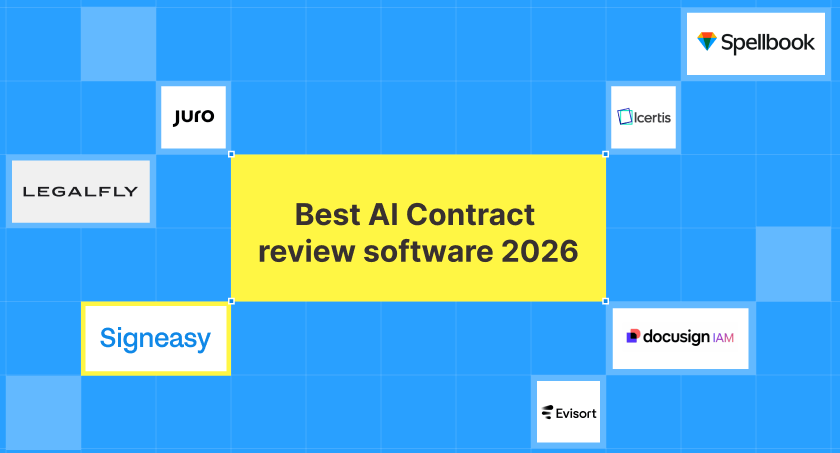That’s the number of Google Workspace users who use Google Drive for file storage. Chances are, you’re one of the 2 billion users who rely on Google Drive to store and manage all sorts of documents.
But do you know Drive can also streamline a common headache that comes with document management—signing PDFs, images, Google Docs, and Sheets? In this blog post, we’ll walk you through the exact process of signing PDFs electronically using Google Drive. So, let’s get started!
What are the prerequisites to sign PDFs in Google Drive?
If you frequently deal with PDFs requiring your signature, here’s what you’ll need to sign it electronically within Google Drive for a smoother workflow:
1. A Google account: You’ll need a Google account first to use Google Drive. If you don’t have an account yet, this is the time to get one!
2. Access to Google Drive: This cloud-based storage will offer you secure and encrypted access to the PDF.
3. An electronic signature tool or add-on: Google Drive does not have a built-in eSignature feature. However, plenty of eSignature tools and add-ons seamlessly integrate with Drive. One of the most popular and easiest options is Signeasy’s Google Drive integration. Some users also prepare their sign-off in advance with an online signature generator before importing the file into Drive.
Step-by-step guide to signing a PDF in Google Drive
This walks you through signing a PDF in Google Drive on your computer.
- Start by logging into your Google account and head to drive.google.com
- On your drive, open the PDF you wish to sign.
- Click the “Open with” button at the top and choose “Connect more apps.”
- A Google Workspace Marketplace popup will appear on your screen. In the marketplace’s search bar, type “Signeasy.”
- Once you see Signeasy on the results, click the “Install” button to start the installation process.
- Choose a Google account where you want to install the Signeasy add-on.
- Signeasy will request access to your chosen account. Click "Allow" to proceed. The installation and connection should take just a few moments.
- Return to the PDF document you want to sign within Google Drive. Right-click on the file and choose "Open with" followed by "Signeasy."
- The PDF will open in a new tab within the Signeasy editor interface.
- Locate the "Signature" option within the left-hand fields sidebar. Drag and drop the "Signature" field onto the designated area where you want your signature to appear.
- A pop-up window will appear, allowing you to create your signature. You can draw your signature, type your signature, or upload an image of your signature.
- Once your signature is created and positioned correctly, you can edit the PDF further by adding your name, date, or any other required fields.
- When all edits and signatures are complete, click the "Finish Signing" button to complete the process.
Pro tip: The first time you use the Signeasy add-on, make sure to log in and create an account to get signing and collecting signatures. If you don’t have an account, Signeasy offers a 14-day free trial that allows you to sign and send documents for signatures up to three times. No credit card is required to sign up for the free trial.
How to sign a PDF in Google Drive on iPhone
Sometimes, you’d want to sign a PDF in Google Drive while on the move. Here’s how you can sign it on your iPhone device.
- Start by launching the Google Drive app on your iPhone device.
- Locate the PDF document you wish to sign. If the PDF is not currently stored within your Drive, you can upload it by tapping the “+” button and selecting it from your device’s storage.
- Once you have located the PDF, tap on it to open the document. Head to the top right corner of your screen and tap the three horizontal dots button. This will open a drop-down menu.
- Select "Open With" from the dropdown menu and then choose “Signeasy.” If you haven’t installed the Signeasy app, download it from the App Store.
- The PDF will now be opened within the Signeasy app. Find and tap the "Start Signing" button.
- A pop-up menu will appear. Within the pop-up menu, you will be presented with choices such as "Sign Document," "Send for Signature," and "In-Person Signing." Select the "Sign Document" option to proceed with signing the document yourself.
- It will open the Annotations menu. Here, you can either upload a pre-saved image of your signature, draw your signature directly on the screen, or type your name for signature.
- Place your signature at the designated location on the document. Once satisfied, tap the checkmark icon in your screen's top right corner.
- A confirmation pop-up will appear; select "Yes" to confirm the signing process.
How to sign a PDF in Google Drive on Android
In case you use an Android device, here’s how you can sign a PDF in Google Drive.
- Open the Google Drive app on your Android device.
- Find the PDF you want to sign. If it's not uploaded yet, tap the "+" button and select it from your device's storage. Then, tap on the PDF to open it.
- Tap the three-dot menu icon in the top right corner of your device.
- From the menu, select “Open with” followed by “Signeasy.” You can download the app from the Google Play Store.
- The PDF will now open within the eSignature app. Tap the "Start Signing" button at the bottom of your screen.
- A pop-up menu with various options will appear. Within the pop-up menu, tap the “Sign Document” option.
- Now, either draw, type, or upload your signature. Once you've done so, place it at the designated location on the document.
- Tap the confirmation icon (a checkmark) in the app's top right corner.
- A confirmation pop-up will appear; select "Yes" to confirm the signing process.
Why sign PDFs electronically?
Traditionally, signing PDFs involved a clunky process: printing documents, signing with a pen, scanning the signed copies, and emailing them. This process is not only time-consuming but also prone to errors. On top of it, traditional PDFs can be vulnerable to unauthorized edits.
Electronic signatures are globally accepted, they’re more secure and tamper-proof. And the best part? They’re environmentally friendly and don’t create unnecessary paper copies. Here are some more reasons why signing PDFs electronically can be the best decision for you:
1. Easy to use
Electronic signature tools are designed for ease of use. Uploading your PDF, designating the signing order, and sending it for signatures can be done in minutes. Recipients can sign from any device, regardless of location. This eliminates geographical barriers and streamlines the entire agreement process.
2. Legally binding
Electronic signatures are legally binding in most countries. Many platforms comply with regulations like the ESIGN Act and eIDAS Regulation. These regulations ensure that electronically signed documents have the same legal validity as traditional ink signatures.
3. High-security standards
Another reason to sign PDF online electronically is the high-security standards. Most eSignature software uses advanced security, such as encryption, SSO, audit trails, and digital signature certificates, to safeguard documents and prevent unauthorized access.
4. Advanced fields
Crafting fillable PDFs for frequent use can be tiring. You spend ages positioning each field just right, only to repeat the process for every new contract. It can be equally painful for the signers to review the entire PDF and look for sections needing signing.
However, eSignature tools like Signeasy offer advanced fields that automatically guide signers to add info like names, dates, and even checkboxes. This saves you time and ensures everyone fills out the document correctly.
Take SVA NYC’s example here. The School of Visual Arts in New York City seamlessly overcame its signature woes and document management hassles by integrating Signeasy with its existing Google Workspace, including G-Drive and Gmail.
Given that SVA was already using Google Workspace, Signeasy’s ability to integrate seamlessly with its suite of applications was a total win for the school: for example, users can receive, open, sign, and send off a document without having to leave their Gmail or Google Drive window. That’s both a time-saver and a headache-saver.
Brian Nakahara, IT Director
Tips for using eSignature tools
The digital signatures market is booming, projected to reach nearly $39.11 billion by 2029. This growth rate reflects the increasing need for efficient and secure ways to sign agreements electronically.
Through time-saving templates, automated workflows, unlimited storage, and multiple integrations, Signeasy eSignature users experience a boost in productivity by 90%. Clearly, eSignature tools are a great addition to your scaling business needs.
However, with so many options out there, picking the right tool can be tricky. Complex features and hidden costs can turn a seemingly simple tool into a costly mistake. When you need a reliable online document signature platform, evaluating these features is crucial to your decision.
1. Compliance
Your eSignature platform holds valuable business data and customer information. Make sure the tool you use clearly shows they’re compliant with relevant global regulations like the ESIGN Act, eIDAS, and UETA.
2. Audit trails and digital signature certificates
Electronic signatures are considered legally valid, but what happens if a signature's authenticity is questioned? This is where audit trails and digital signature certificates come in. This feature captures and stores detailed information about each document’s signing process. Digital signature certificates also captures tampering, once the document is sealed. To ensure your chosen platform offers robust protections, check that its audit trail provides a record of the following:
- Timestamps for all signatures
- Signer's IP address
- Signer's name and email address
- Detailed documentation of any changes made to the document
3. Multiple signing options
Always use a tool that offers various signing options beyond just a traditional click-to-sign approach. Consider offering in-person signing options. This allows customers who may not have access to a computer or prefer a face-to-face interaction to sign documents electronically on a tablet or mobile device at your location.
4. Good customer support
The best customer support goes beyond just answering questions. Look for a tool that offers training materials and onboarding resources (how-to videos, webinars, blogs, guides) to ensure a smooth transition for your team.
This ensures a smooth adoption process for your team, minimizes disruptions during the signing process, and ultimately contributes to a positive customer experience.
Troubleshooting common issues with eSignatures in Google Drive
Even though signing PDFs electronically is smooth, you might occasionally encounter hiccups. But don’t worry; these can often be fixed with simple steps.
Here’s how to troubleshoot some common issues people face when signing PDFs in Google Drive:
1. Authorization issues
Ensure you're signed in to the correct Google account linked with the eSignature tool or add-on. Verify that the eSignature tool has the necessary permissions to access and modify your Google Drive files. You should revisit the add-on settings and grant access again.
2. Signature not displaying correctly
Ensure the PDF you wish to sign isn’t corrupted. Try downloading the PDF and opening it in another PDF viewer to see if the signature displays correctly. Sometimes, specific formatting in the PDF can cause issues with how your signature appears.
Check if your eSignature tool has any known compatibility problems with certain PDF formats. For example, Signeasy supports 25+ document types such as PDF, Word, Excel, Open Office, PNG, JPG, and HTML.
Wrapping up
So there you have it! Signing PDFs electronically in Google Drive is simple. The process becomes faster and more secure, especially with the help of an eSignature tool like Signeasy.
Whether managing complex PDFs, simple NDAs, or anything in between, Signeasy empowers you with robust features and eSignature solutions. It’s the perfect tool to streamline your PDF signing process, enhance security, and boost efficiency.











